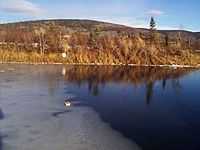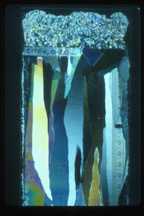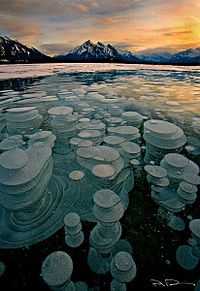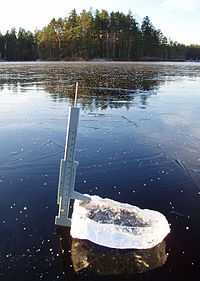Minerals/Ices/Black ices
< Minerals < Ices
Black ice (congelation ice) "forms as water freezes on the bottom of the ice cover and the latent heat of crystallization is conducted upwards through the ice and snow to the atmosphere."[1]
Glaciology

Black ice "growth rate is proportional to the rate at which energy is transferred from the bottom surface of the ice layer to the air above."[1]
At the right is a vertical thin section through the black ice of the pond. It shows granular snow ice (top) and columnar black ice (bottom).
Water ice

"Congelation ice is often referred to as black ice because it has a high optical depth that permits significant light transmission to the underlying water."[1]
The image on the right shows high optical depth and bubbles trapped and frozen under a thick layer of ice.
Weather
"Meteorological factors such as air temperature, precipitation, wind speed and radiation balance coupled with physical characteristics of the lakes and ice (lake area, depth, volume and fetch; snow depth; ice thickness, type and albedo) lead to complex interactions and feedbacks that affect the timing of freeze-up and break-up (ice cover duration) each year."[1]
Earth
"Lake ice occurs primarily in the Northern Hemisphere [of Earth], where most of the ice is seasonal: it forms in the autumn, thickens during the winter and melts in the spring."[1]
Locations on Earth

In Swedish kärnis means "blue ice", whereas the English term is "black ice". Lots of "blue ice" occurs on lakes with clear water over a sandy bottom. At right is an image of black ice (kärnis) on Lake Vättern.
Research
Hypothesis:
- Black ice indicates slow freezing.
Control groups

The findings demonstrate a statistically systematic change from the status quo or the control group.
“In the design of experiments, treatments [or special properties or characteristics] are applied to [or observed in] experimental units in the treatment group(s).[2] In comparative experiments, members of the complementary group, the control group, receive either no treatment or a standard treatment.[3]"[4]
Proof of concept
Def. a “short and/or incomplete realization of a certain method or idea to demonstrate its feasibility"[5] is called a proof of concept.
Def. evidence that demonstrates that a concept is possible is called proof of concept.
The proof-of-concept structure consists of
- background,
- procedures,
- findings, and
- interpretation.[6]
See also
References
- 1 2 3 4 5 ALISON (05 September 2014). "LAKE ICE: Ice Formation". Alaska, USA: Alaska Lake Ice and Snow Observatory Network. Retrieved 2014-09-05.
- ↑ Klaus Hinkelmann, Oscar Kempthorne (2008). Design and Analysis of Experiments, Volume I: Introduction to Experimental Design (2nd ed.). Wiley. ISBN 978-0-471-72756-9. http://books.google.com/?id=T3wWj2kVYZgC&printsec=frontcover.
- ↑ R. A. Bailey (2008). Design of comparative experiments. Cambridge University Press. ISBN 978-0-521-68357-9. http://www.cambridge.org/uk/catalogue/catalogue.asp?isbn=9780521683579.
- ↑ "Treatment and control groups, In: Wikipedia". San Francisco, California: Wikimedia Foundation, Inc. May 18, 2012. Retrieved 2012-05-31.
- ↑ "proof of concept, In: Wiktionary". San Francisco, California: Wikimedia Foundation, Inc. November 10, 2012. Retrieved 2013-01-13.
- ↑ Ginger Lehrman and Ian B Hogue, Sarah Palmer, Cheryl Jennings, Celsa A Spina, Ann Wiegand, Alan L Landay, Robert W Coombs, Douglas D Richman, John W Mellors, John M Coffin, Ronald J Bosch, David M Margolis (August 13, 2005). "Depletion of latent HIV-1 infection in vivo: a proof-of-concept study". Lancet 366 (9485): 549-55. doi:10.1016/S0140-6736(05)67098-5. http://www.ncbi.nlm.nih.gov/pmc/articles/PMC1894952/. Retrieved 2012-05-09.
External links
![]() This is a research project at http://en.wikiversity.org
This is a research project at http://en.wikiversity.org
| |
Development status: this resource is experimental in nature. |
| |
Educational level: this is a research resource. |
| |
Resource type: this resource is an article. |
| |
Resource type: this resource contains a lecture or lecture notes. |
| |
Subject classification: this is a Geology resource. |